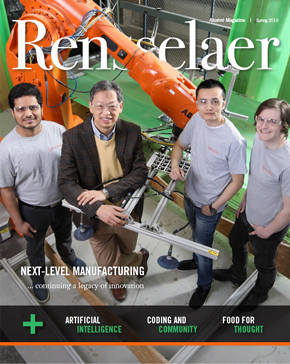
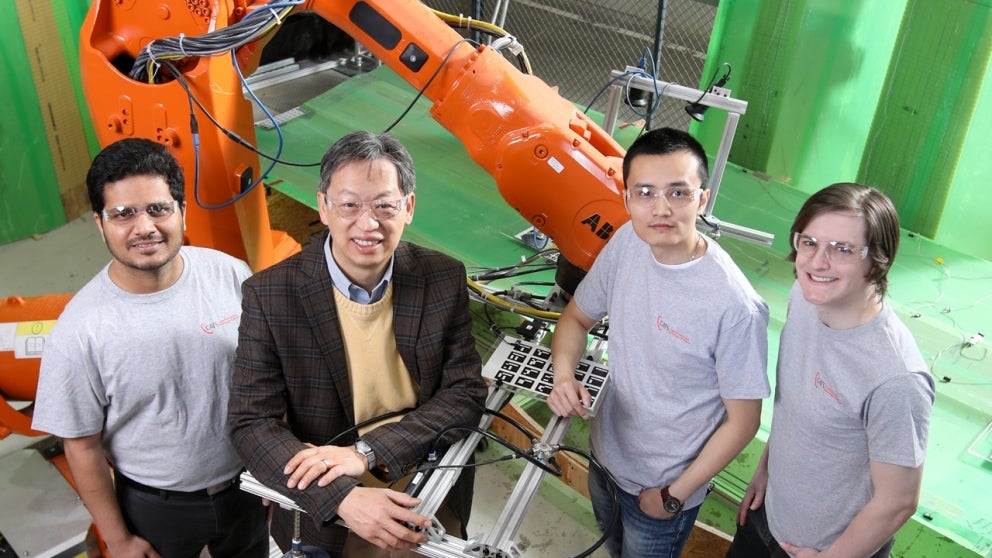
Advancing Manufacturing
By Jane Gottlieb
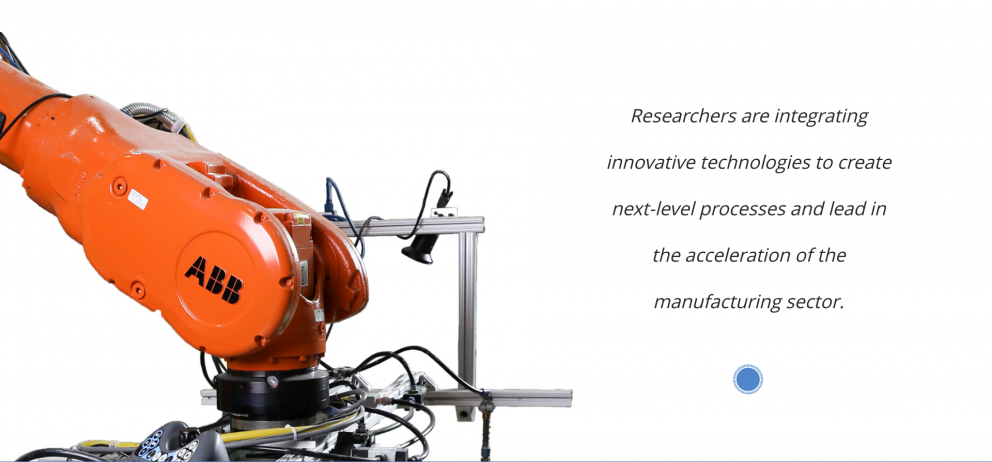
John Wen is excited by the prospect of using robots to monitor illness and help disabled individuals with household chores.
“I’m thinking about a home assistant you could ask to get something from the fridge or put in the microwave, to give people a level of independence,” explains Wen, the Russell Sage Professor, who heads the Department of Electrical, Computer, and Systems Engineering. “And I think some form of this is even possible in five to 10 years.”
Sam Chiappone ’99 is inspired by the students who go on to influence the way our products, tools, and technology are made.
“We’re not just teaching somebody ‘this is what manufacturing is.’ We teach them lessons they use to work for Regeneron, Apple, or wherever they go,” says Chiappone, director of manufacturing innovation at the School of Engineering.

Steve Rock is eager to see New York industry benefit from the new generation of lightweight parts that can be 3D printed in small quantity.
“I’m really interested in how digital information can drive the manufacturing process, to make complex components better, faster, at a reduced cost,” says Rock, M.S. ’91, Ph.D. ’00, director of digital manufacturing at the Rensselaer Center for Automation Technologies and Systems (CATS).
And Morgan Locandro ’20 wants nothing more than to see her work launched into space.
“I’d love to see the parts I’ve been working on used in space satellites,” explains Locandro, a Rensselaer junior majoring in mechanical engineering, who does actually work on space satellites as an intern with NASA’s Jet Propulsion Laboratory.
All are driven by the legacy and future of manufacturing.
A devotion to innovating how a wide variety of materials are made permeates the culture at Rensselaer—from the highest-level research in biomedicine, data analytics, materials science, robotics, nanoscience, and smart manufacturing, to the instrument-filled labs where products and processes are formulated.
Advanced manufacturing — rapidly applying the newest technologies of science to produce goods — encompasses dozens of Rensselaer departments, programs, and research centers. The goals are just as broad: help companies become more competitive, extend our reach into space, fight disease at home, and make life easier for individuals with disabilities.
Researchers across campus leverage funding from the National Science Foundation, NASA, the Department of Defense, the Department of Energy, the National Cancer Institute, and Empire State Development’s Division of Science, Technology and Innovation. They partner with other leading universities and they collaborate with large companies like GE and Boeing, as well as many small businesses.
But the school is perhaps most distinctive for the opportunity it gives students to experience, and even influence, the field.
Undergraduate and graduate students assist with grant-funded research, work with industry, and take part in internships and co-ops, as well as manufacturing-themed competitions and clubs. Rensselaer recently won state approval to offer a graduate certificate focused on advanced manufacturing.
And students at all levels make things.
“Our students are not going to go on to run the machines,” explains Chiappone, who has supervised scores of student manufacturing projects in 38 years at Rensselaer. “They’ll be the ones to design the process, do the research into new processes, and figure out ‘How do I take this idea and make it a reality? How do I manage people?’ They need to understand how it’s done. They might be in charge of a whole company, or starting a new one.”
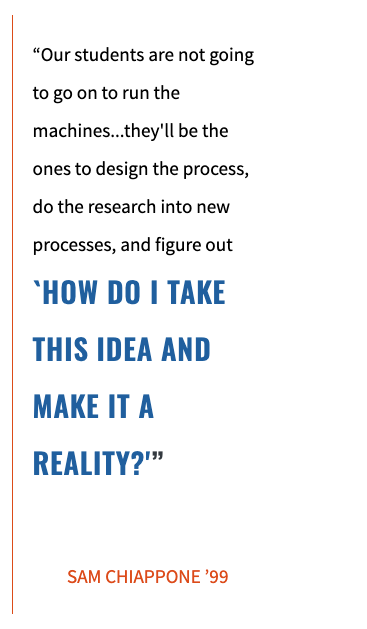 No Longer Dull, Dirty, or Dangerous
No Longer Dull, Dirty, or Dangerous
The Manufacturing Innovation Learning Laboratory (MILL) at Rensselaer is among the collection of spaces in the George M. Low Center for Industrial Innovation (CII) where products are made and processes tested. One morning last fall, a team of students in Chiappone’s Manufacturing Processes and Systems class met to discuss their challenge: a six-by-nine-inch plastic pinball machine that needed to be produced the following semester.
“It’ll work! It’ll work!” said Benjamin Spooner, a senior majoring in mechanical engineering, studying the design on his laptop, as teammates added input.
Getting this far had meant using computer-aided design to come up with a concept and simulate it, developing a budget, a project management plan, and supporting documentation, all while making modifications.
They would later input the information into a computer numerical control machine, which “tells” the printer — a machine housing a vise, laser, reamer, and drills — to create a metal mold of the pinball machine components. The mold would go into a machine that injects it with plastic to make the game parts.
If all went well, the digital data and age-old tools would produce 400 miniature, perfectly functioning, games.
“There are a lot of parts. The first design was more elaborate. We learned how to simplify how we made it,” noted Rachel Stagnitti, a senior majoring in mechanical engineering.
A hundred years ago, production of basic machine tools transformed society. Manufacturing entailed lines of workers doing repetitive tasks, often in dangerous conditions. Factory work faded as operations moved offshore. But in the past 20 years, Chiappone has seen something of a rebirth. Computers, often programmed remotely, have increasingly taken on the job of running the machines.
Today, much of manufacturing happens in clean, often quiet, settings like the MILL. Factory work means understanding datasets, cloud computing, and simulation. Engineers seek control at all phases.
“Things should be done in unison,” Chiappone explains. “We shouldn’t have a designer just do his design and give it to someone who says, ‘we can’t make that.’ If the design-build is done together, we’re prototyping what we’ve created together. We simulate before committing.”
AngioDynamics, Boeing, GE Global Research, and other companies support the MILL in hopes of cultivating new talent.
“They’re looking for engineers with an understanding of basic processes, coupled with skills in digital manufacturing, process simulation, and an integration of augmented reality and virtual reality technologies in manufacturing, all to gain efficiencies related to production,” Chiappone says.

Advanced Manufacturing Advanced
As it stands, the Manufacturing Institute projects a two-million worker shortage by 2025. Not only are baby boomers retiring, but there are not enough qualified science, technology, engineering, and math students coming out of colleges and universities.
In response, companies are investing in K-12 STEM education and training community college students in the jobs they most need. They offer wage incentives and on-site daycare for employees who relocate.
Rensselaer is among the universities playing an aggressive role in strengthening the manufacturing sector. Across campus, research scientists do everything from developing nano-engineered materials to training massive robots. It would be challenging to list all the stakeholders devoted in part or fully to advanced manufacturing.
Among them, the Scientific Computation Research Center simulates physical, chemical, and biological systems to foster product design and process optimization. The Center for Biotechnology and Interdisciplinary Studies experiments with pharmaceutical agents to create disease-fighting drugs. The Center for Lighting Enabled Systems & Applications studies the design, manufacturing, and impact of LED systems.
Faculty in business, economics, cognitive science, architecture, and the humanities, meanwhile, tackle problems of efficiency, supply chain, fault detection and mitigation, facility design, and the intrinsic human variables.
In addition, Rensselaer actively boosts New York industry. The CATS, which opened in 1989, for example, is one of 15 centers designated by the New York State Foundation for Science, Technology and Innovation to work with client companies. The Rensselaer Center for Future Energy Systems is another.
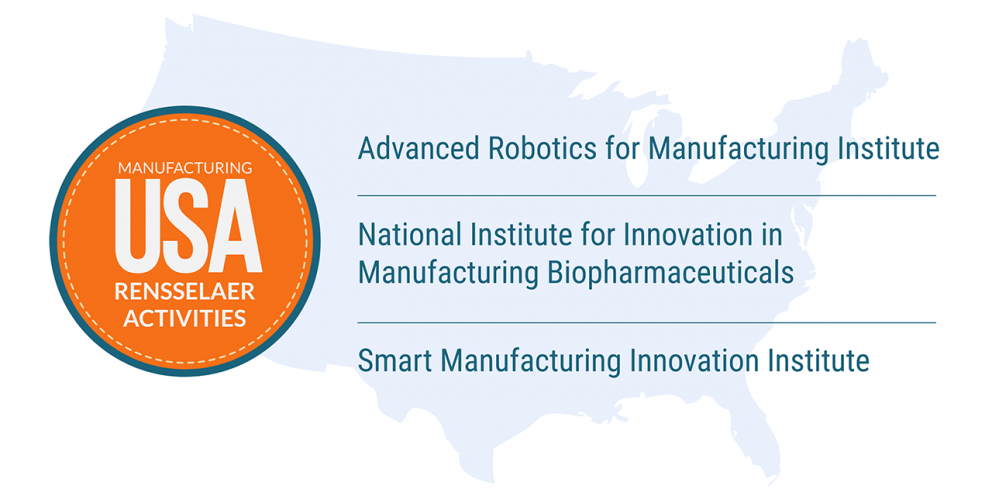
And when President Barack Obama created the blockbuster Manufacturing USA initiative, Rensselaer was ready.
Funded by government and industry, the initiative links early research to product design through 14 research institutes. Rensselaer plays an active role in three: the Advanced Robotics for Manufacturing Institute, the National Institute for Innovation in Manufacturing Biopharmaceuticals, and the Smart Manufacturing Innovation Institute.
Like a huge tree with countless branches, these institutes have spawned still more partnerships and regional hubs, putting millions of dollars into advanced manufacturing. Rensselaer’s efforts have already produced results.
As a regional leader in the Smart Manufacturing Innovation Institute, for example, Rensselaer was tapped to launch a chip manufacturing center at GlobalFoundries, in Saratoga County, to test software and train future semiconductor workers. Researchers devoted to next-generation robots were also ready to leverage the new opportunities.
Robots that Collaborate
In a caged manufacturing test facility in the CII, a hulking orange robot located a large composite panel, moved it across the tight space, and placed it down within a millimeter of another piece. The panels lined up perfectly. Guided by sensors and cameras, the robot did this repeatedly.
“It took about a minute for the image processing, motion planning, and motion execution,” says John Wen, who spends much of his time devising algorithms to get robots to take on human tasks. “We’d like to speed it up.”
If robots can maneuver panels and similar items, he reasons, wind turbine blades and other large structures can be built in segments and assembled more efficiently in the factory. This will significantly reduce cycle time, minimize human labor, improve quality, and make wind turbine blades and other components more cost effective.
This project, a collaboration with GE, is funded through the Advanced Robotics for Manufacturing Institute (ARM). It has been less than two years since the federal government named Rensselaer a founding ARM member. But Wen’s team is now just months from submitting results. These will be shared with other ARM members, and the open source software made available to the public.
“GE will evaluate it and decide whether to take it to the factory level,” he explains.
Robots have worked American assembly lines for at least 50 years, says Wen. Today, they build most car exteriors. The interiors, however, like so many functions, still demand the visual acuity and dexterity of humans.
He and his Rensselaer colleagues see robots becoming intelligent collaborators, like the orange device moving panels, thanks to sensors, cameras, and advanced computation. The ARM initiative also wants robots scaled, and priced, for small companies.
“Small businesses still do a lot of work by hand and invest a lot of time and money to trick out a problem or rely on the one person who is computer savvy,” he explains. “How do you make a robot truly plug and play? How do you train the workforce to see that robots will free humans up to pursue other things?”
In a nearby lab, a student at a computer works on a NASA-funded project to get robots to capture space satellites for refueling. Students also work here with Baxter robots, the human-friendly devices with arms. Outfitted with wheelchair wheels, the so-called Baxter on Wheels has even retrieved a water bottle off a shelf and fetched an item from the fridge.
Wen envisions robots that bring an elderly person food, remind her to take medicine, and even monitor congestive heart failure and other medical conditions. The barriers are significant — and include teaching robots to respond, say, to a person with dementia.
But he is quick to note that it wasn’t long ago that simply installing a home computer was a feat.
“Making an impact in society is in Rensselaer’s culture,” he points out. “Our founding principle from 200 years ago included ‘applying science to the common purposes of life.’”
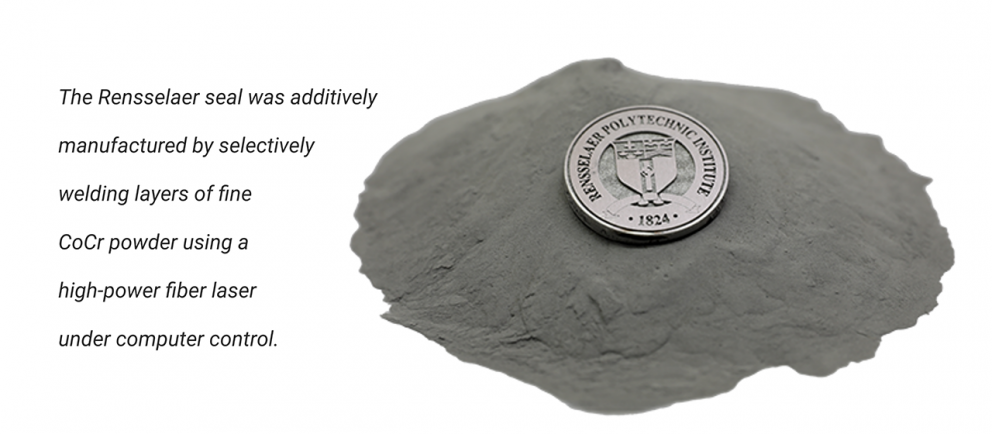
Adding Layers to the Equation
Manufacturing has long relied on churning out as many can openers or door knobs as fast as possible. Today, though mass production remains the norm, Rensselaer researchers see promise in producing less of something.
“Automation does the same thing over and over. But there’s also automation that is highly programmable and can be used to tailor the manufacturing process to each unique set of customer wants,” says Steve Rock of the CATS. “The question is, how do you get hard tooling out of the process and gain flexibility?”
In a departure from the traditional practice of creating a can opener or soap dish from a larger chunk of metal or plastic, Rock’s lab builds highly specialized parts layer by layer. Additive manufacturing, as it is known, uses thousands of thin layers of metal or plastic powder that are shaped by digital information and a powerful laser.
As a result, Rock notes, parts that formerly required dozens or even hundreds of other parts to produce can be made as a single piece. They can be produced one at a time and evaluated. Additive parts not only reduce waste, but are lighter, adding up to significant cost savings for aerospace and other industries. Using additive manufacturing, the CATS has helped New York companies create 376 jobs and retain 374 more in the past decade.
Other Rensselaer researchers also rely on this customized manufacturing. Biomedical engineers, for example, use the additive process to print living cells and create precise 3D tumor models. Among the goals: examine the disease of an individual patient.
Rensselaer and Albany Medical Center are now using a $3.7 million National Cancer Institute grant to develop breast tumor models that capture cellular complexity and new imaging techniques that can show how drugs interact with the cells.
Associate Professor of Biomedical Engineering David Corr, one of the principal investigators, hopes to minimize the variability that makes cancer research daunting.
“If the same tumor cells are implanted into 10 mice, you could get 10 unique tumors,” he explains. “Even people with the same cancers respond differently to the same drug. We want to create patient-specific models that capture important 3D biologic complexities, and do so in a controlled and reproducible manner. This can ultimately lead to tailored diagnostic tests to determine which treatment holds the most promise for a given patient.”
While Rock makes tools that build aircraft and Corr makes human tissue, their work is surprisingly similar.
“Most people probably picture manufacturing as welding robots on assembly lines,” Corr says. “They’d be surprised that manufacturing can also involve automated cell printing and tissue engineering. This is really straight-up additive manufacturing — we use a CAD/CAM-based process to print materials. The only difference is that we are printing living biologics.”

The Next Leaders
Morgan Locandro lost little time finding the additive lab after arriving at Rensselaer as a freshman. She landed an undergraduate research grant to work there, and has been helping build and improve the lab’s metal additive printer ever since.
“I designed a magnetically coupled actuator to spread metal powder back and forth for each layer of printing, while holding a vacuum seal,” says Locandro, now a junior, pointing out hardware in a chamber roughly the size of a stackable washer-dryer packed with gears, wires, and tubes. “My design was able to transfer the motor’s torque into a sealed chamber, while maintaining vacuum.”
Rensselaer students have, in fact, designed many components of the three-dimensional printer and made improvements to the open source software that drives the system.
“At a lot of schools it might take a few years before you’d be able to utilize all that you’ve learned,” says Locandro, who like other student researchers in the additive lab does classwork here when she’s not clocking hours.

It would be difficult for students interested in manufacturing to avoid the opportunities available. When students are not in classes, or taking part in internships and undergraduate research, they might engage in robotics competitions and spark their interest at campus manufacturing forums and events. There are even manufacturing-themed clubs such as The Forge, where a community of students work on class projects and simply share their interest in designing and manufacturing things.
For Locandro, the array of experiences at Rensselaer has made all the difference. At the start of sophomore year, she was selected for an interview with NASA. She produced a resume from her backpack, some designs she was working on for the additive lab, and sketched out her ideas. She landed an eight-month paid internship with the NASA Jet Propulsion Laboratory in Pasadena, California that spring.
There, Locandro wrote programs to test the torque and speed needed on the actuators of three satellites scheduled to launch in 2020. From the beginning, she says she felt confident in her abilities, thanks to “the numbers-crunching aspect” and hands-on opportunities she has at Rensselaer.
“The experience I gained here put me a step ahead of the game since I was already well-versed in many common engineering programs and practices,” says Locandro, who has been invited back to Pasadena for the summer.
“I got to jump straight into the technical work. I took all the little things I’ve been learning all the way and brought them to NASA,” she says.















